Interesting Memorials

Cemetery Gates
Through these gates on 7 May 1846, the Bishop of Winchester processed to...
Read moreCemetery Gates
Through these gates on 7 May 1846, the Bishop of Winchester processed to consecrate the Anglican section of the new burial grounds. The structure is one of a quartet of buildings that have been at the cemetery since its beginnings, the others being the - former – Lodge, Anglican chapel, and Non-Conformist chapel. The gate and Lodge are built in the Tudor style of architecture. Cowled, mourning faces are carved on the outside of the stone pillars, representation of a king and a queen on the inside. Two stone griffins, that once surmounted the pillars are long gone. The Arms at the top of the arch, inside and out, are those of the County Borough in 1846. They are shown in colour on the gates themselves. The gates were made, especially for the cemetery, by the Eagle Foundry, Northampton and their symbol of that bird is on the lock of one gate. They are sometimes said to be the Stag Gates that once stood at the junction of The Inner Avenue and Lodge Road but that is not correct. In 2011, the gates were restored, cleaned and re-painted thanks to Southampton City Council, Abbey Services and Elliots Independent Builders. It is from the main gates that FoSOC Guides start their walks.

Mausoleum
The word ‘Mausoleum’ derives from one of the Seven Wonders of the Ancient World, the tomb provided for Mausolos (Mausolus), the ruler of Halicarnassos (Halicarnassus). Mausolea take the form of buildings and can be elaborate or, as in the example in the Old Cemetery, relatively small like a little house but always featuring an access doorway. In Père Lachaise Cemetery at Paris there are streets lined with such small ‘houses’. The Nicholas Mausoleum is the only one at the Southampton Cemetery and was built by local well known stonemasons Garrett & Haysom. Their order book survives and shows a sketch of the proposed monument and the price, in December 1901, as £170. In today’s money that equates to around £14,600. Council Minutes record that this mausoleum was damaged during the Second World War but we have not yet been able to find the details or if any claim was submitted after the war ended. The rusty lock on the door indicates that no one has been inside for many, many years!
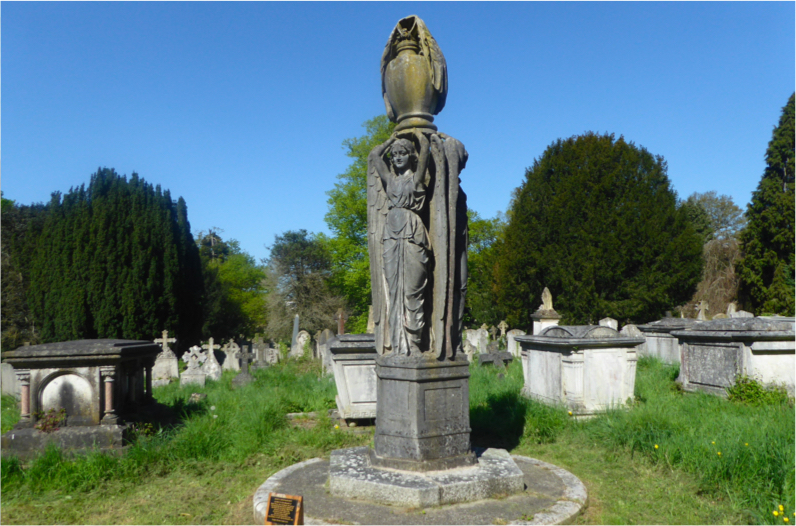
Pearce Memorial
This fine sculpture, located close to the former Anglican chapel and representing Faith, Hope and Charity, stands over the grave of Robert Pearce, a banker who died in 1861, and other members of his family. It might have fallen, broken, and thus been lost some years ago. The underground arch on which the memorial rests had begun to collapse, causing the base to break up and putting the figures into a leaning position. Fortunately, thanks very much to the concern and attention of John Avery, a Founder of FoSOC, who took up the matter with SCC, and the timely work instituted by the council, the monument, a Grade II listed structure in the cemetery, was secured and is safe though the angle of tilt is still clearly evident. The websites for British Listed Buildings and Historic
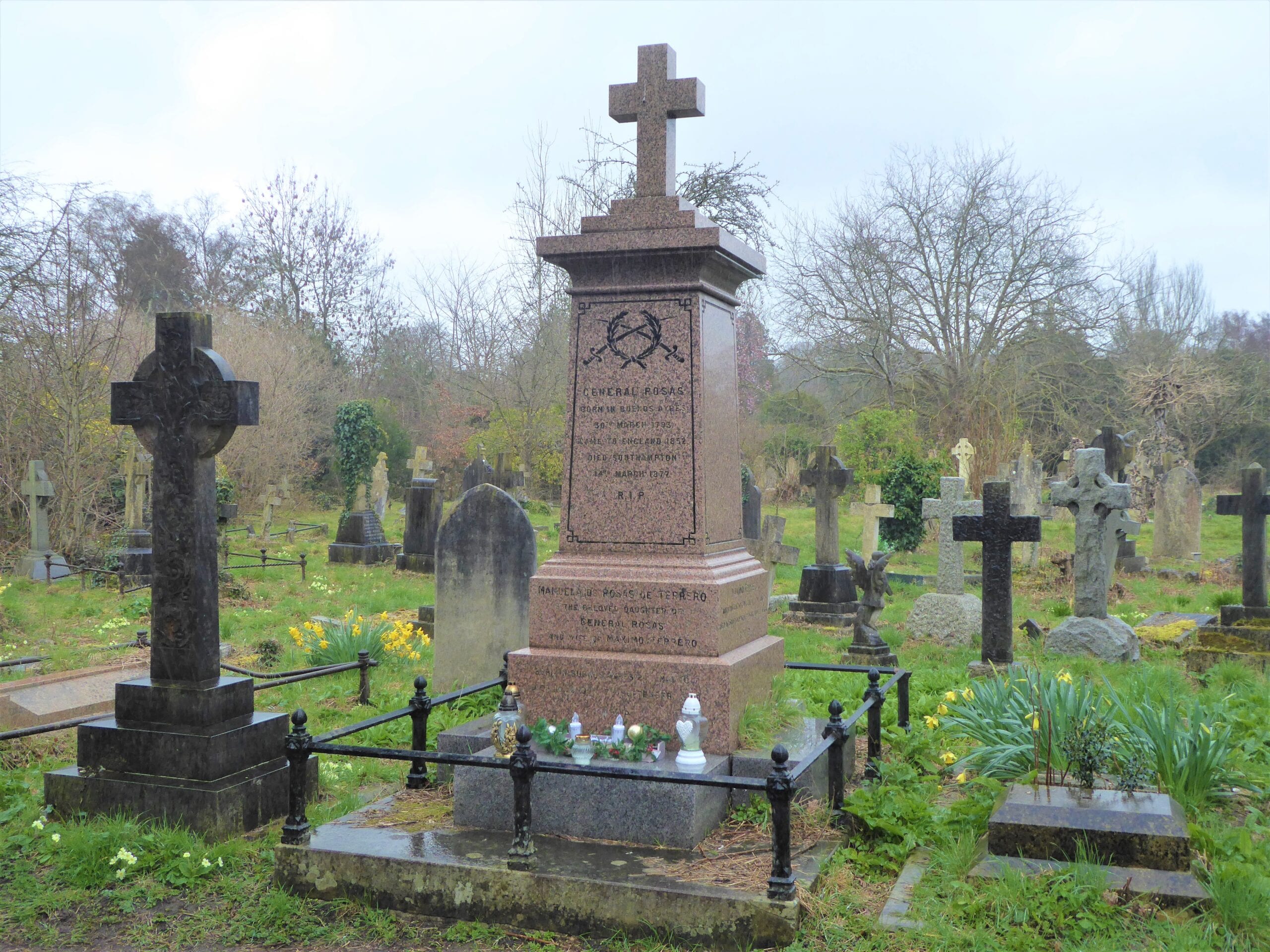
General Juan Manuel de Rosas memorial
This is a sought-after monument in the cemetery, despite the fact that the General has not been here since 1989! General Rosas was an Argentinean dictator, who was forced, for his own safety, to leave his country in 1852 and who spent the rest of his life in Southampton, dying here in 1877. By the 1960s there were moves to bring his remains back to Argentina. For various reasons, including the Falklands War in 1982, this was not done until 1989. He now rests in La Recoleta Cemetery at Buenos Aires, the burial place, too, of Eva Peron (‘Evita’). The Southampton grave, that still contains members of the General’s family, always attracts interest and is often featured on our guided walks that explore, here, the different aspects of a varied life.
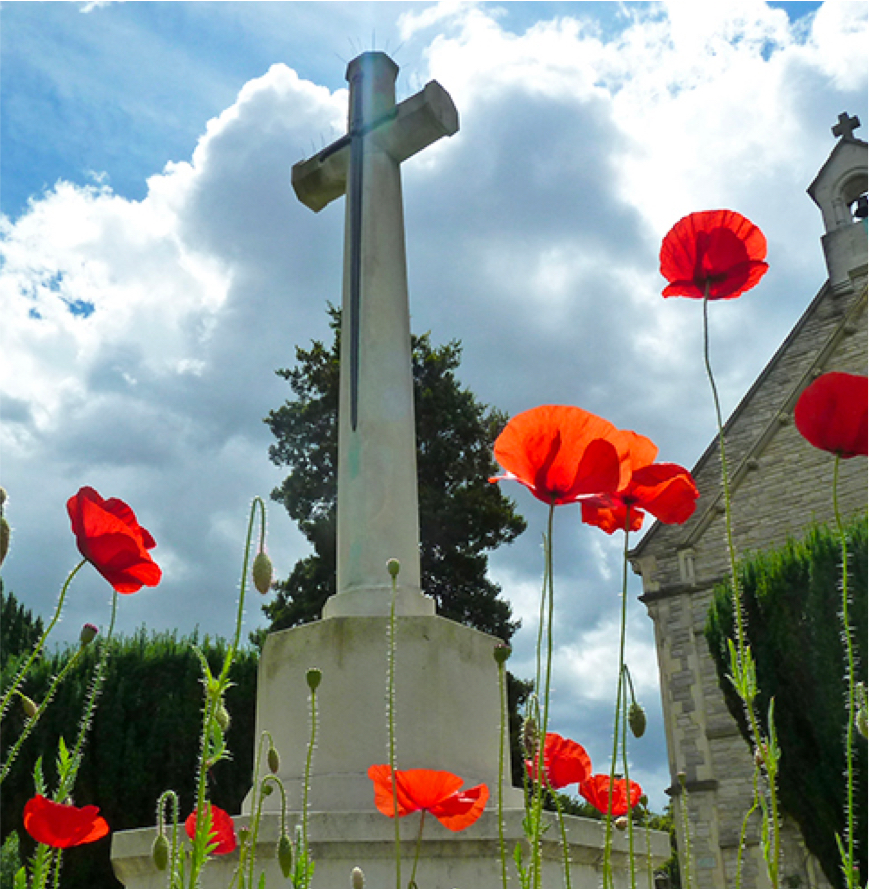
The Cross of Sacrifice
Just inside the main entrance gates the Old Cemetery’s Cross of Sacrifice, signifies that, within the cemetery, there are burials from both World Wars, the total known, at present, being 127. The Cross, to the design of Sir Reginald Blomfield, one of the Imperial War Graves Commission’s architects, was placed here after the First World War. Each year, on Remembrance Sunday, the Cross and the Belgian memorial, also at the cemetery, are the foci for FoSOC’s public annual commemorations when wreaths are laid at both places and all war dead remembered. There are no War Grave Plots as such, the burials being scattered throughout the cemetery. FoSOC is honoured to be entrusted by CWGC and SCC with the care of these graves, including those of Belgians, who died in, and near, Southampton during the First World War and who are buried by their memorial, unveiled in 1916. Our team of dedicated volunteers ensure that there is access to the war graves for visitors wishing to pay their respects. Shortly before each Remembrance Sunday, FoSOC members place Poppy Crosses at all the World War graves in the cemetery.

Captain George Smith R.N.
Like the Pearce memorial, this one – to George Smith who died in 1850 –...
Read moreCaptain George Smith R.N.
Like the Pearce memorial, this one – to George Smith who died in 1850 – is unique in the Old Cemetery. It features an upside-down boat, representing a paddle box lifeboat (for the design of which Smith received an award) and, originally, there were naval related features. The latter commemorated that George Smith was the first commander of HMS Excellent, the Royal Navy School of Gunnery at Portsmouth. Sadly, the memorial is badly weathered, and sections are breaking from it. It was made from Beer Stone, a lovely creamy colour, and the Old Stone Quarry at Beer, on the Devon coast, can still be visited. A guidebook explains that: ‘In addition to being formed in natural layers the stone has a lateral grain, which governs the plane in which it is used. Before removing the block from its position (in the Quarry), the vertical was always marked and continued to be no matter how many times the original block was cut into smaller ones.’ The stone for the Smith monument was, evidently, used in its wrong plane; rain has intruded leading to freezing and expansion of moisture resulting in the damage that has been, and is being, caused.
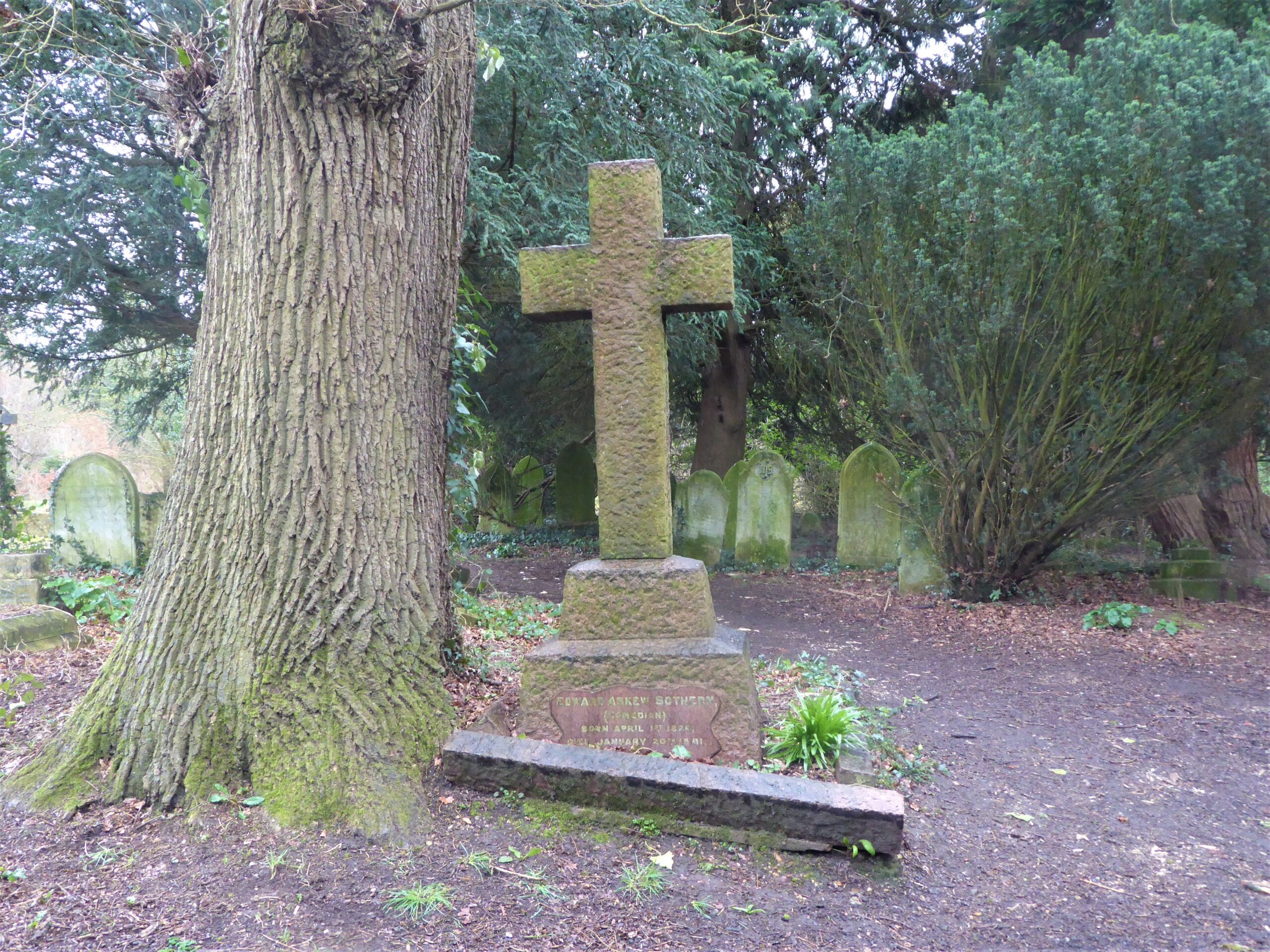
Edward Askew Southern
Visiting this substantial monumental cross, it will be noticed, on the...
Read moreEdward Askew Southern
Visiting this substantial monumental cross, it will be noticed, on the base, that Edward Sothern, who died in 1881 and is buried here, is described as a ‘Comedian’. To the Victorians, who once walked around this cemetery, that one word was sufficient for he was a well-known comic stage actor. He is particularly associated with the part of Lord Dundreary in the play ‘Our American Cousin’, an interpretation of the role he largely created for himself. This was the play being performed at Ford’s Theatre in Washington D.C. when President Lincoln was assassinated on 14 April 1865, though Sothern was not performing that night. A very fascinating story is brought to life by FoSOC Guides at the graveside of this great actor.

John Ross
This grave, although marked by name on the cemetery map, did not have a headstone until 2009. Maclean/Ross - who was famous in South Africa, while still young, and later for his stance on anti -slavery - died on a ship coming into Southampton in 1880. Fraserburgh History Society, from his hometown, and FoSOC worked closely together to ensure he was properly remembered. FoSOC members organized fund raising for the stone and a re-dedication ceremony that was attended by distinguished guests including the Mayor of the city and a representative from Fraserburgh. This was followed by a Reception. FoSOC deeply appreciates being able to have been so actively involved with remembering a most important man and we tell his story on appropriate cemetery walks taken by FoSOC Guides.
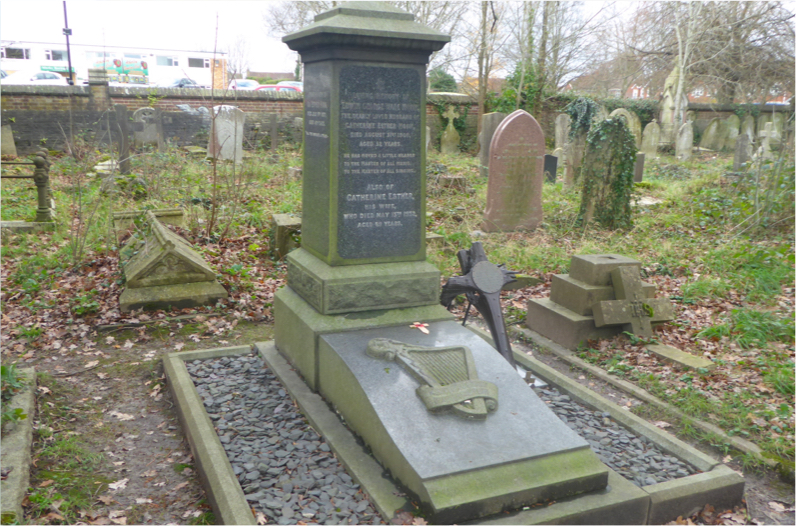
Squadron Leader Edwin Rowland Moon
In 1909, Edwin Moon achieved the first powered flight in this area at what is now Southampton International Airport. He went on to serve in the First World War with the RNAS and RAF and was killed in a flying accident in 1920. In 2009, the Southampton & Eastleigh Branch of the Royal Air Forces Association (RAFA), in conjunction with FoSOC, marked, at the grave, the centenary of the first flight and, in 2020, had planned to commemorate the centenary of Edwin Moon’s death but that was not possible due to the Covid-19 situation. Mr David Maber - with Edwin’s cousin, Roland Moon - wrote a biography, the copyright in which he generously gave to FoSOC. Maintenance of the grave is in the personal care of FoSOC member, Bruce Larner, who takes many of our photographs. Some years ago, the wooden marker was in danger of rotting away but Bruce treated it with preservative, and continues to do so, ensuring the existence of a unique memorial within the cemetery. FoSOC member, John Virgo, is also a member of the local branch of RAFA and was involved with the 2009 commemoration. It was John, and David Maber, who – in the very early days of FoSOC – told us the story of Edwin Moon and asked us to locate the grave. It has been cared for ever since that time.
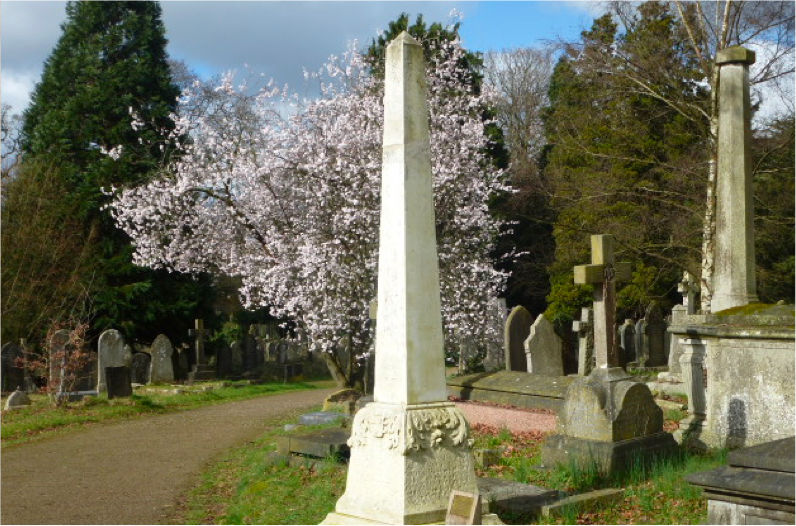
Boer War Memorial
For many years, all that could be seen here was the much-weathered plinth...
Read moreBoer War Memorial
For many years, all that could be seen here was the much-weathered plinth with the broken apex of the column lying, part buried, nearby. The broken pillar, for some reason, had been taken to the northern part of the cemetery and abandoned. A few years ago, thanks to two members of FoSOC, pillar, apex and plinth were re-united and are able to be seen, once again, together, in the memorial restored by Allstone, stonemasons of Shirley in the city. This is an example of a memorial without bodies beneath it. It was provided as a tribute, a first of its kind, to those from Southampton who went out to the South African War in 1900,as part of the Southampton Volunteer Ambulance Corps, three members dying there, in service, of disease. All others from the Corps returned home safely to tell their stories..
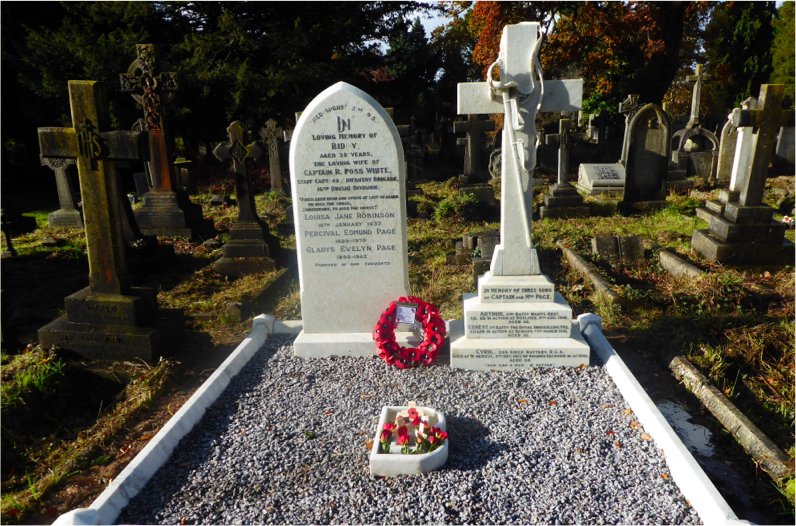
Page Family Grave
We can imagine, only too well, the distress of next of kin, during the...
Read morePage Family Grave
We can imagine, only too well, the distress of next of kin, during the First World War, receiving a telegram - or a letter from a commanding officer - notifying the death of a relative. The Page family of Southampton experienced that on three occasions, for each of three sons in three successive years of the war, 1916, 1917 and 1918. The memory of the men, and their parents, was recorded on the family grave at the Old Cemetery, close to the Cross of Sacrifice. Over the years the grave fell into considerable disrepair, the stone becoming discoloured and the sacrifice passing unknown to those who did not know the family’s story. For the centenary of the Armistice on 11 November 2018, FoSOC - having first obtained permissions - had the parts of the memorial cleaned, re-erected and restored thanks to the work of Allstone, Stonemasons of Shirley, Southampton. Now the memory of three lives lost in the Great War can, once again, be seen by visitors to the cemetery. This is part of FoSOC’s ongoing commitment to honour those who died in the World Wars by caring for their graves in the cemetery and our Cemetery Guides keep memory alive with their dedicated, respectful, guided walks.
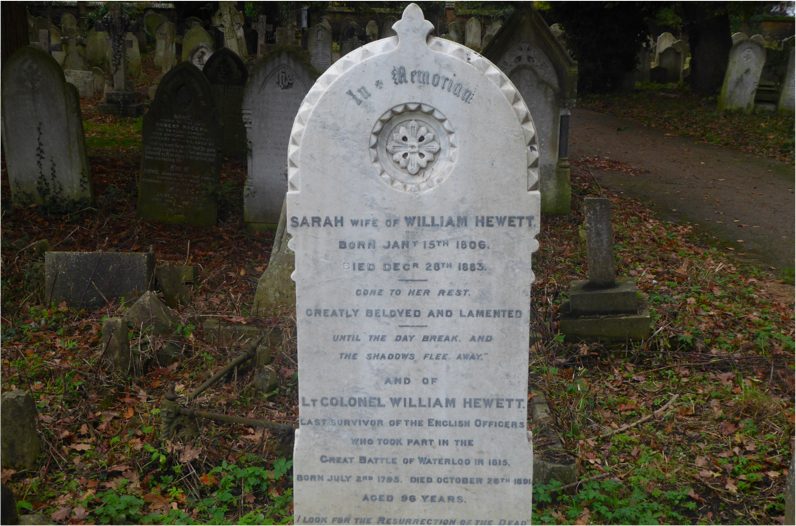
Captain William Hewett (later Lt. Colonel)
Many of us will feel a certain ‘tingle’ when a single word is used to remind of a famous battle - for instance, Hastings, Agincourt, Trafalgar and…Waterloo. William Hewett was there, at Waterloo, the battle described by the Duke of Wellington as ‘The damn-nearest run thing you ever saw in your life’. Hewett was not yet 20 at the time and he lived on to the age of 95, dying in 1891. He was the last of the British (his stone says ‘English’) officers from the great battle. On walks we stand very close to the grave and recount what happened to his regiment on 18 June 1815, the day when ‘ Boney’ was defeated.

Edward Bist
While remembering the tragic death of Fireman, Edward Bist, in a railway accident at Bishopstoke station (now Eastleigh) in 1870, this headstone is a lasting tribute to the skills of the masons who carved the memorials for families in this, and all other, cemeteries. It depicts the railway engine that was involved in the fatal accident right down to the coal in the tender and the brushes at the front to keep snow off the line. The reproduction of detail, in stone, is remarkable as well as the story of the train accident itself and the untimely death of Edward Bist.
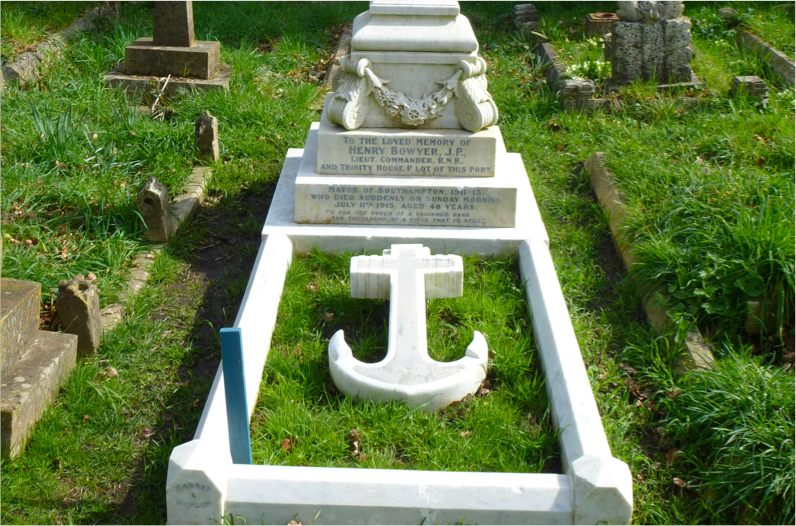
Henry Bowyer – Mayor /Titanic
Southampton will, forever, be linked with the loss of RMS Titanic on 15...
Read moreHenry Bowyer – Mayor /Titanic
Southampton will, forever, be linked with the loss of RMS Titanic on 15 April 1912. Alderman Henry Bowyer was Mayor of the town that year (a much loved and respected man) and, when the news of the sinking became known, he immediately began what was, initially, a Titanic Relief Fund. This was to give locally, financial assistance to families of those who died. Over the years, parts of the memorial became dislodged though not broken. In 2012, thanks to permission from Southampton City Council, the Bowyer grave was restored to its original state by FoSOC. To commemorate the centenary of the Titanic tragedy in 2012, FoSOC arranged a memorial service at which the restored grave was re-dedicated. This was attended by descendants of the Bowyer family, the Mayor of the city, FoSOC President, Professor James Stevens Curl, and Mrs Curl, with a Guard of Honour from the Royal Naval Reserve in which Henry Bowyer had, himself, served as a Lieutenant Commander, as well as many members of FoSOC and the public.
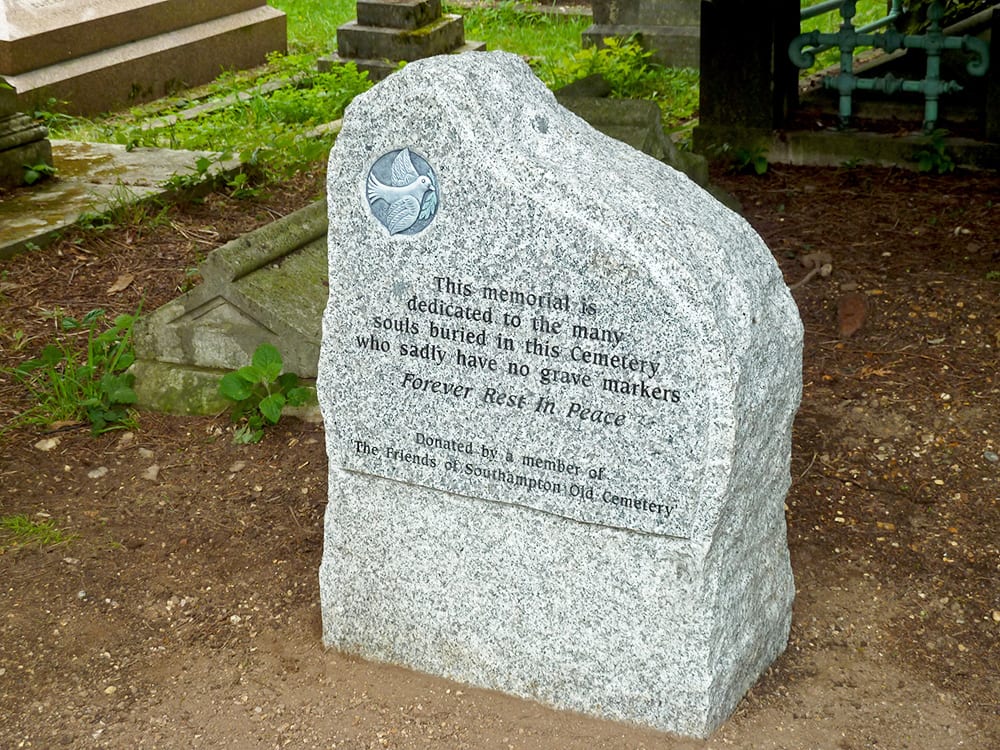
Beautiful Memorial for those without a grave marker
The Victorians placed great importance on the grave, and remembrance at it, but by no means did all have money to spend on burial or marker. The Holloway family lived in one of the 'courts' off lower Brewhouse Lane, now long gone and, today, a curiosity of old photographs. These were largely wretched slum areas, the subjects of a devastating medical report in the late 19th century. Today the area, with its modern homes, is in the sought after 'French Quarter' of Old Southampton. In the 1881 Census the parents, with 6 children and a lodger, occupied one of the cramped properties. In 1882, the father, James Holloway, aged 46, died at 7, Brewhouse Court. We know, from the cemetery register, where and when he was buried. It was in a 'common grave' that eventually held, in addition to James, 20 other people. We can only imagine the distress of the widow, Elizabeth, as she stood by the grave seeing the coffin disappear beneath, probably, just a light layer of earth knowing that James was not the first, nor would he be the last, to be interred there. Six bodies were already in the grave and, after James was buried, there would be 14 more. Tragedy struck the family, again, in 1884 when the youngest child, George, died aged 3. Elizabeth Holloway no doubt attended the burial but this was in a separate grave though not far away. The child was not buried with the father even though, in 1884, there was a burial there and the last one in the grave was interred in 1888. It seems that, from somewhere, Elizabeth was able to find the money to bury her son, so avoiding a 'common grave', because he is the only one in that grave. How many times she returned to mourn we do not know but neither grave has any marker. Usually, there are no markers on 'common graves' and, we presume, Elizabeth could not afford one for George. Was the experience of her husband's burial so awful that she did everything to ensure the same did not happen with her son? The graves are only some 30 yards apart. The remaining family seem to have moved away as Elizabeth is not in the Old Cemetery. Father and son are just two of the many souls in the cemetery whose graves are not marked. It is people such as James and George that the very generous FoSOC benefactor would have had in mind when the new stone was commissioned recently - so they would not be forgotten. The donor is very moved that so many people have left messages saying how much they love the new memorial, because they have family buried at the cemetery, without markers, and greatly appreciate the lovely gesture.
Become a Friend of Southampton Old Cemetery
Membership is open to anyone interested in the Cemetery and who support our aim to balance conservation with the need to protect its heritage and social history.